Tuesday, May 12, 2009
Update from the world of Miller & Mullet
On or around Canada, or the 4th of July if you prefer, Miller & Mullet will be launching a whole bunch of stuff.
With artist Kam Gates, we're kicking off a weekly comic strip. Think of it as the Addams Family (the original Addams' strips) meets Ziggy, or Hitchcock meets Garfield. Something like that. At any rate, Mullet and Kam are coming up with some darkly funny stuff that works best in the 3-5 frame world of comic strips.
Alongside the strip, we're launching a tri-weekly radio series starring Miller and Mullet. I'm doing the post stuff on that project, as well as most of the writing. The nice thing about audio-only is that sound effects are a lot cheaper than visual effects, so we can finally put some ideas to work without having to worry about how much it costs. The radio show will be available on our website and will, hopefully, be available via iTunes as a podcast. Look for Miller & Mullet Radio.
And, as the third prong of our 2009 Extravaganza, we're posting our 2003 project, Babysitters, in chapters on Youtube and as video podcasts at iTunes. Each week, we'll release another chapter in our first major project. this will be the first time Babysitters has been seen since our rough cut screening at Christmas of 2002.
Back to work!
Saturday, May 2, 2009
The HV30 White Balance, Part 2
 Okay, now the histograms for our white balance experiment. The first four look similar in the red, green, and blue channels, but there is a significant difference in the luminance (black graph) channel, with more spikes for the Custom white balance setting (unsurprising given it responds to whatever you put in the lens while setting it). It is different from the fully-automated setting, but the spikes are in the same neighbourhood, as is the bump to the left of the spikes.
Okay, now the histograms for our white balance experiment. The first four look similar in the red, green, and blue channels, but there is a significant difference in the luminance (black graph) channel, with more spikes for the Custom white balance setting (unsurprising given it responds to whatever you put in the lens while setting it). It is different from the fully-automated setting, but the spikes are in the same neighbourhood, as is the bump to the left of the spikes.The two fluorescent settings differ in the luminance channel more than they do in the 3 colour channels. This makes sense as the fluorescent-corrected is intended for lights shifted from the greens of regular fluorescent lights (measured as 4100-4400 K colour temperature) towards the bluer temperature of sunlight (5000-6500 K). Shooting in real daylight creates one spike (or 3 shoved together?) for the daylight-corrected setting, but 3 distinct spikes for the conventional fluorescent setting.
 Looking at the actually Daylight setting, it resembles the fluorescent setting in terms of the luminance, and not the corrected one. Interesting, and not what I expected.
Looking at the actually Daylight setting, it resembles the fluorescent setting in terms of the luminance, and not the corrected one. Interesting, and not what I expected.The Shade setting pushes the 3 spikes of the Daylight setting together, with nearly identical colour channel readings for both. The Cloudy setting, by comparison, has luminance spikes somewhere between Daylight and Shade, which makes sense.
 Finally, the tungsten setting, which is designed for the 3000K colour temperature of the halogen incandescent bulb (I’m guessing the 2700K average for conventional incandescent are probably okay with this setting, too). I’ve grouped it with the two fluorescent settings (which I’ve misspelled, perhaps reflecting my past work in the restaurant business…) to see what the 3 artificial light settings do.
Finally, the tungsten setting, which is designed for the 3000K colour temperature of the halogen incandescent bulb (I’m guessing the 2700K average for conventional incandescent are probably okay with this setting, too). I’ve grouped it with the two fluorescent settings (which I’ve misspelled, perhaps reflecting my past work in the restaurant business…) to see what the 3 artificial light settings do.Based on this third histogram comparison, I’d say that the more corrective the white balance setting, the more spikes and shifts in the luminance and colour graphs. The Tungsten and Fluorescent settings correct strong red and green shifts, respectively, by changing the image much more than what we see in the three natural light settings and the daylight-corrected fluorescent settings.
Tuesday, April 28, 2009
The HV30 White Balance, Part 1
 First up, the automatic white balance. I’m guessing the camcorder looks around for the whitest-looking pixels and picks them to represent what white should be. Here, the snow in the park hands the camcorder an easy one.
First up, the automatic white balance. I’m guessing the camcorder looks around for the whitest-looking pixels and picks them to represent what white should be. Here, the snow in the park hands the camcorder an easy one.
The snow looks somewhat grey in the sunlight—only the snow across the road in front of the building looks white. Let’s see what the daylight setting does: The snow is whiter in this shot, so I’ll avoid the automatic setting, at least on sunny days.
The snow is whiter in this shot, so I’ll avoid the automatic setting, at least on sunny days.
Next, the cloudy setting. The sky on the day of the shoot was clear and bright, so this is not the setting’s best test:
Next, we get into the Shade setting. I assume this setting works to level out contrasts between things in shadow and any hotspots in the same frame?

Leaving natural light settings, we get into the white balance settings for artificial light. First up, the tungsten setting, probably the worst to use in daylight since it’s looking for a much cooler light temperature: Yup, that’s definitely the wrong setting. Nothing that colour correction in post couldn’t fix, but I’ll bet the reds and greens are probably not as vibrant. We’ll see with the histogram next time.
Yup, that’s definitely the wrong setting. Nothing that colour correction in post couldn’t fix, but I’ll bet the reds and greens are probably not as vibrant. We’ll see with the histogram next time.
Next on the bulb part of the tour is the normal fluorescent bulb setting: This isn’t that bad at first glance—certainly a bit darker, but it’s not blue like the tungsten setting, and the brown building still looks brown. The histogram will tell the tale.
This isn’t that bad at first glance—certainly a bit darker, but it’s not blue like the tungsten setting, and the brown building still looks brown. The histogram will tell the tale.
Next is the daylight-balanced fluorescent setting: This looks less blue than the normal fluorescent setting. The histogram comparison should be fun!
This looks less blue than the normal fluorescent setting. The histogram comparison should be fun!
Finally, we get to the custom setting, or the manual white balance. In order to ensure that the framing was identical to the other white balance settings, I didn’t zoom into the sunlit snow to get an accurate white balance as I would normally do, so the white balance in this clip is based on the entire frame you see here: This doesn’t look too bad—the whites look white, the blues look blue, and the browns look brown. The histogram will tell the tale.
This doesn’t look too bad—the whites look white, the blues look blue, and the browns look brown. The histogram will tell the tale.
That concludes the white balance comparison for this week. Next week, the long-anticipated histograms of these shots, just to see just how the colour balance changes from setting to setting.
Monday, April 13, 2009
The HV30 Special Scene Recording Programs, Part 2

Tuesday, February 24, 2009
The HV30 Special Scene Recording Programs, Part 1
The HV30 comes loaded with a whole bunch of presets for typical situations that someone might come across while shooting. There are eight settings (Portrait, Snow, Sports, Spotlight, Beach, Night, Sunset, and Fireworks), and I shot footage with the HV30 in 1080 60i mode, shooting just 10 seconds per setting in order to minimize the shifting sun (directly behind the camera).

First up, the Snow Mode, just because I’m shooting a snowy field. As seen above, the image looks pretty good, with what appears to be balanced colour. The snow in the sunlight looks blown out, though.
The snow in shadow and in the sunlight halfway up on the left doesn’t look blown out, nor does the park sign just right of centre. Something with this setting doesn’t like a mix of shadow and light, even if it’s snow. The tree shadow in the lower right has a slight tint to it—somewhat magenta? That would mean the red and blue is cranked up or the green channel is cut. I’m definitely interested in seeing the histograms for this series of test images!
Next, the Beach Mode:

First thing I noticed was that the shadow of a bare tree (lower right) has lost the magenta the Snow Mode gave it, but the detail is about the same. The broken snow in the lower right is not defined very well—it looks blown out like in Snow Mode. The red channel is definitely subdued here—look at the brick building and the concrete pole on the left side of the image and the office building across the road.
Our third setting of the day is the Night mode. Shooting a snowy field on a bright winter’s day is probably not the best way to test this setting, but I was interested by the differences with this mode compared to Snow and Beach:

Looks darker overall, but I think that’s what anyone would expect. What is interesting is that the broken snow on the lower right is sharp and not blown out. The brick building and the concrete pole have more red to them like the Snow mode compared to the Beach mode, so at this point I’m thinking the Beach mode must chop the red channel down compared to Snow and Night. Good to know!
Next, the Portrait mode. Designed for making people look good in close-ups, probably by doing something with the red channel, here’s what it does with a snow-covered park:

Like the Night mode, this is not the best subject to shoot with this mode. The image is dark, but the broken snow is not blown out, and the brick building and concrete pole don’t seem to have lost any of the red as in the Beach setting. I was struck by how similar this image was to the Night mode image—I had to go back and make sure I hadn’t used the same image twice by mistake. When I do another round of tests, I’ll have to find a better subject to fully understand how the Portrait Mode affects the HV30’s performance.
Next, the Sports Mode. My first guess was that this mode would speed up the shutter speed to better capture fast action, but I have a TV with a sports setting that shifts the colour balance away from the red channel (the TV’s movie setting definitely warms up and image by shifting towards the red).

Here’s what the Sports Mode did with my snowy park. It resembles the Portrait and the Night Modes. The broken snow is not blown out, and the image is darker overall. The red in the brick building and the concrete pole doesn’t look altered at all (a red car happened to pass through and other than being dark, it looks red).
Next, the Spotlight mode. Interesting to see how it compensates for the dark and light areas in the frame—it seems to darken everything equally:

The dark is definitely darker, and the lighter areas are definitely darker, too, so this is clearly the wrong setting to use in this type of situation. I’m looking forward to comparing the histograms for the last 3 modes, just to see what the differences are.
Next, I fired up the Sunset Mode (which I assume could be used for sunrises, too?).

It looks like it’s somewhere in the middle of the pack. The broken snow is still sharp, and the red channel doesn’t look suppressed, but it’s a brighter image.
Finally, my favourite of these tests: the Fireworks mode. Not surprisingly, a snow-covered park doesn’t work with this image at all. I captured a perfectly white image:

I never suspected changing the recording program on the HV30 would crack me up, but this one did! Rest assured, I shot all 10 seconds of this blank shot like the others (and the HV30 still worked after I was done). This setting must work better in low-light, high-contrast situations. Again, this is one I’ll have to test under much different conditions.
Next time, the histograms of these pics to see what exactly the HV30 did for each mode.
Tuesday, February 17, 2009
The HV30 Recording Programs, Part 2
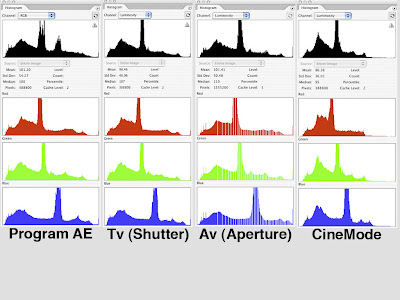
Continuing from last week, here are the histograms for the HV30 program mode tests. I used the same TIFF files as last time, loading them into Photoshop. The histograms are screen captures from Photoshop.
I had to head to Wikipedia to figure out how to read these graphs, so I'm relying on the information there being accurate! The top row (in black) shows the luminosity for each setting, with the left side being the darkest and right the brightest. The higher the peak, the more pixels there are in the image at that particular luminance.
The colour graphs show the locations of the RGB pixels, with the darkest values on the left and the lightest values on the right. Therefore, a white pixel will appear on the far right side of all four graphs, and a black pixel will appear on the far left of all four.
The overall shape is roughly the same for each program setting, with that somewhat phallic peak in the centre or to the right of the centre, but there are some significant differences between them.
In the Program AE mode, where the HV30 has complete control over the shutter and aperture settings, the camcorder spreads the phallus into three distinct columns for luminosity reading, and adds a peak to the right side where the other settings have a slight bump.
The Av and Tv histograms are nearly identical, so I’ll need to do more testing. I have read opinions favouring shutter or aperture control for shooting quality video, so this bears further testing to see what works best with the HV30 in a wider range of tests.
The Cine Mode setting shows the most differences between itself and the other three programs. This mode really clamps down on the brightest 1/3 of the luminosity and the three colour channels. The lower end, the blacks, is also a bit different—the little spikes, particularly in the blue channel, are compressed compared to the other graphs. Where Cine Mode boosts the image is the mountain to the left of the phallus—all four readings are higher there than the other three program settings. This finding matches what I've read about how the film-look settings on camcorders work to match how film captures luminosity and colour.
This round of test shows what the four program settings can do. I can see that the Cine Mode is significantly alters the image, so I will definitely pursue further testing with these settings in other conditions, particularly the Tv and Av modes. I don't know if the Cine Mode's changes can be reversed in post, so I want to see if another mode provides a better canvas to do colour-correction in post.
Next week, the special scene recording programs.
Wednesday, February 4, 2009
The HV30 Recording Programs, Part 1

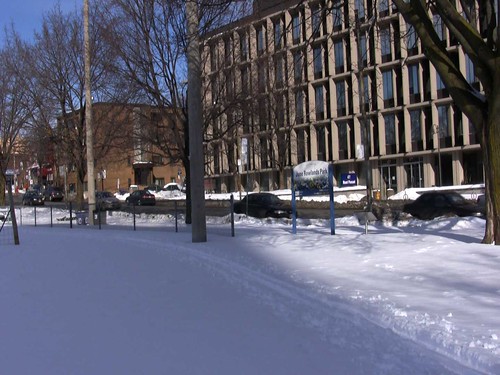
I consider this the baseline since the HV30’s brain is doing all the work. This is what the Panasonic engineers came up with in terms of the optimum exposure settings. There’s not a lot of red, other than the brown brick building to the left and the yellow fire hydrant in the right-centre, so I think the blue channel is probably doing most of the work in this shot. The white snow across the street, in direct sunlight, is pure white here, and the snow and sign in the foreground both look white. And the blue sky is just as blue as it was on the day.
Next, the Tv mode, where the shutter speed is manual and the aperture is controlled by the HV30. In this case, the shutter speed was at 1/100:
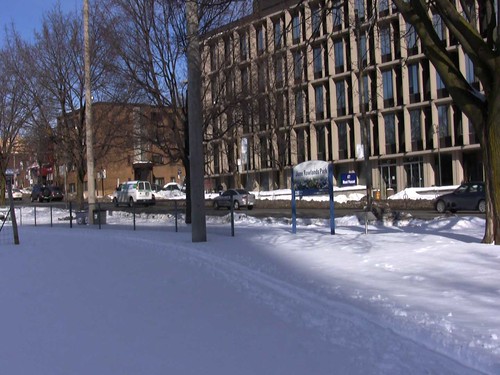
Next up, the Av mode, where the aperture is manual and the camcorder controls the shutter. I didn’t change the aperture value when I switched from Tv to Av, and I didn’t write down what the aperture setting was, so I don’t know what the aperture was actually set at! At any rate, here’s what it looks like:
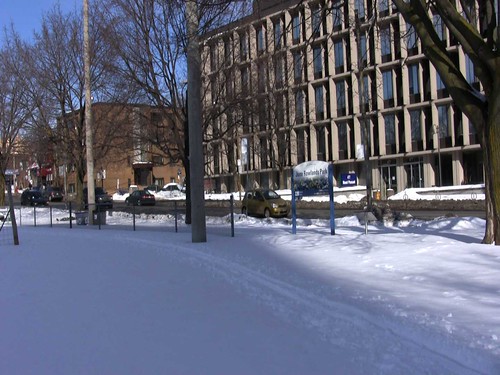
It’s pretty much identical to the Tv mode, so the camcorder didn’t change anything when I went from one setting to the other. I am planning on testing the Tv and Av modes more extensively later on.
Finally, here’s the Cine Mode still. This setting has no manual controls, so the HV30 is doing all the work here but trying to give the image a film-like exposure:
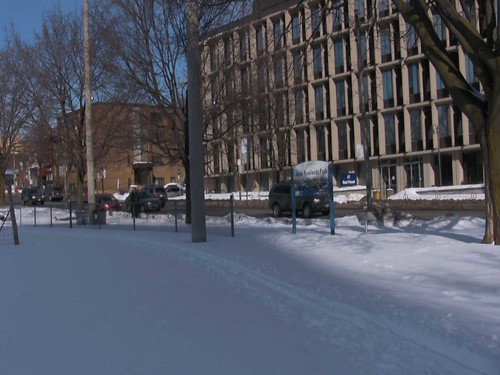
It looks a bit darker, and the snow in the forground looks more grey than blue compared to the previous screen caps. The contrast seems to be compressed a bit—the whites are less bright and the darks are less dark. The colour of the fire hydrant across the road looks the same, but the blue sky is definitely a different tone than the earlier settings.
I will post histograms of these four images next time, just to see what exactly the differences are.